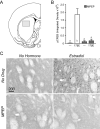Membrane estrogen receptors activate the metabotropic glutamate receptors mGluR5 and mGluR3 to bidirectionally regulate CREB phosphorylation in female rat striatal neurons
- PMID: 20709161
- PMCID: PMC2949475
- DOI: 10.1016/j.neuroscience.2010.08.012
Membrane estrogen receptors activate the metabotropic glutamate receptors mGluR5 and mGluR3 to bidirectionally regulate CREB phosphorylation in female rat striatal neurons
Abstract
Along with its ability to directly regulate gene expression, estradiol influences cell signaling and brain functions via rapid, membrane-initiated events. In the female rat striatum, estradiol activates membrane-localized estrogen receptors to influence synaptic neurotransmission, calcium channel activity, and behaviors related to motor control. Yet, the mechanism by which estradiol acts to rapidly affect striatal physiology has remained elusive. Here we find that membrane estrogen receptors (ERs) couple to the metabotropic glutamate receptors mGluR5 and mGluR3, providing the framework to understand how membrane estrogen receptors affect striatal function. Using CREB phosphorylation as a downstream measure of ER/mGluR activation, membrane-localized estrogen receptor α (ERα) activates mGluR5 signaling to mediate mitogen-activated protein kinase (MAPK)-dependent CREB phosphorylation. Further, ERα and estrogen receptor β (ERβ) activate mGluR3 to attenuate L-type calcium channel-dependent CREB signaling. Interestingly, while this fundamental mechanism of ER/mGluR signaling was initially characterized in hippocampal neurons, estrogen receptors in striatal neurons are paired with a different set of mGluRs, resulting in the potential to functionally isolate membrane-initiated estrogen signaling across brain regions via use of specific mGluR modulators. These results provide both a mechanism for the rapid actions of estrogens within the female striatum, as well as demonstrate that estrogen receptors can interact with a more diverse set of surface membrane receptors than previously recognized.
Copyright © 2010 IBRO. Published by Elsevier Ltd. All rights reserved.
Figures





Similar articles
-
Estradiol activates group I and II metabotropic glutamate receptor signaling, leading to opposing influences on cAMP response element-binding protein.J Neurosci. 2005 May 18;25(20):5066-78. doi: 10.1523/JNEUROSCI.1427-05.2005. J Neurosci. 2005. PMID: 15901789 Free PMC article.
-
Glutamate cascade to cAMP response element-binding protein phosphorylation in cultured striatal neurons through calcium-coupled group I metabotropic glutamate receptors.Mol Pharmacol. 2002 Sep;62(3):473-84. doi: 10.1124/mol.62.3.473. Mol Pharmacol. 2002. PMID: 12181423
-
Phosphorylation of cAMP response element-binding protein in cultured striatal neurons by metabotropic glutamate receptor subtype 5.J Neurochem. 2003 Jan;84(2):233-43. doi: 10.1046/j.1471-4159.2003.01256.x. J Neurochem. 2003. PMID: 12558986
-
Nervous system physiology regulated by membrane estrogen receptors.Rev Neurosci. 2008;19(6):413-24. doi: 10.1515/revneuro.2008.19.6.413. Rev Neurosci. 2008. PMID: 19317180 Free PMC article. Review.
-
Estrogen receptors stimulate brain region specific metabotropic glutamate receptors to rapidly initiate signal transduction pathways.J Chem Neuroanat. 2011 Dec;42(4):236-41. doi: 10.1016/j.jchemneu.2011.02.002. Epub 2011 Mar 31. J Chem Neuroanat. 2011. PMID: 21458561 Free PMC article. Review.
Cited by
-
Estradiol dose-dependent regulation of membrane estrogen receptor-α, metabotropic glutamate receptor-1a, and their complexes in the arcuate nucleus of the hypothalamus in female rats.Endocrinology. 2013 Sep;154(9):3251-60. doi: 10.1210/en.2013-1235. Epub 2013 Jul 3. Endocrinology. 2013. PMID: 23825124 Free PMC article.
-
Membrane-initiated estradiol signaling induces spinogenesis required for female sexual receptivity.J Neurosci. 2011 Nov 30;31(48):17583-9. doi: 10.1523/JNEUROSCI.3030-11.2011. J Neurosci. 2011. PMID: 22131419 Free PMC article.
-
Estradiol signaling in the regulation of reproduction and energy balance.Front Neuroendocrinol. 2012 Oct;33(4):342-63. doi: 10.1016/j.yfrne.2012.08.004. Epub 2012 Sep 7. Front Neuroendocrinol. 2012. PMID: 22981653 Free PMC article. Review.
-
Memory-Related Synaptic Plasticity Is Sexually Dimorphic in Rodent Hippocampus.J Neurosci. 2018 Sep 12;38(37):7935-7951. doi: 10.1523/JNEUROSCI.0801-18.2018. Epub 2018 Aug 1. J Neurosci. 2018. PMID: 30209204 Free PMC article.
-
Sex Differences in Medium Spiny Neuron Excitability and Glutamatergic Synaptic Input: Heterogeneity Across Striatal Regions and Evidence for Estradiol-Dependent Sexual Differentiation.Front Endocrinol (Lausanne). 2018 Apr 18;9:173. doi: 10.3389/fendo.2018.00173. eCollection 2018. Front Endocrinol (Lausanne). 2018. PMID: 29720962 Free PMC article. Review.
References
-
- Augustine GJ, Santamaria F, Tanaka K. Local calcium signaling in neurons. Neuron. 2003;40:331–346. - PubMed
-
- Balthazart J, Ball GF. Is brain estradiol a hormone or a neurotransmitter? Trends Neurosci. 2006;29:241–249. - PubMed
-
- Becker JB. Direct effect of 17 beta-estradiol on striatum: sex differences in dopamine release. Synapse. 1990;5:157–164. - PubMed
-
- Becker JB, Snyder PJ, Miller MM, Westgate SA, Jenuwine MJ. The influence of estrous cycle and intrastriatal estradiol on sensorimotor performance in the female rat. Pharmacol Biochem Behav. 1987;27:53–59. - PubMed
Publication types
MeSH terms
Substances
Grants and funding
LinkOut - more resources
Full Text Sources

